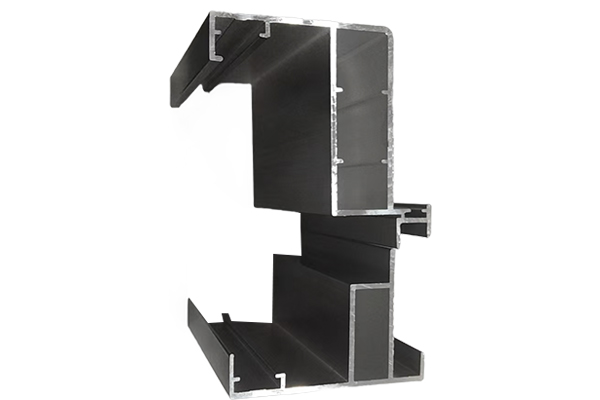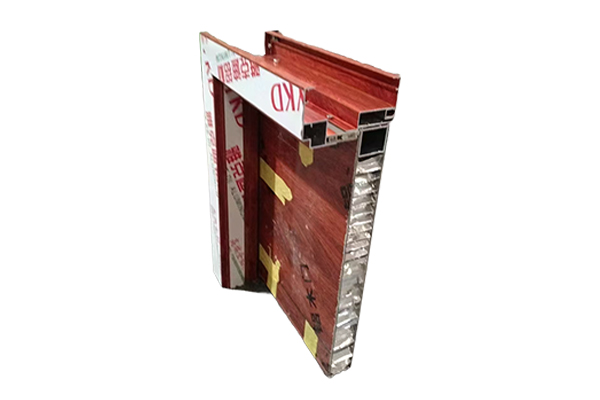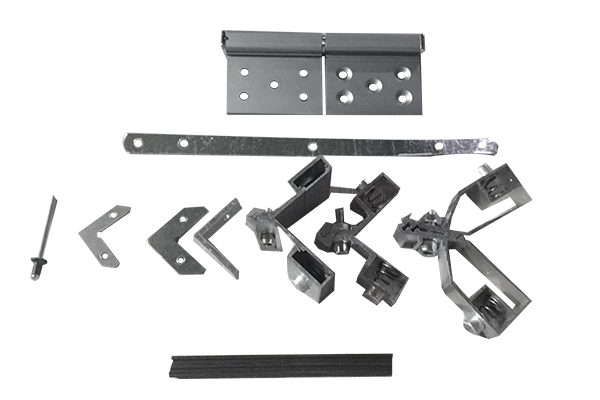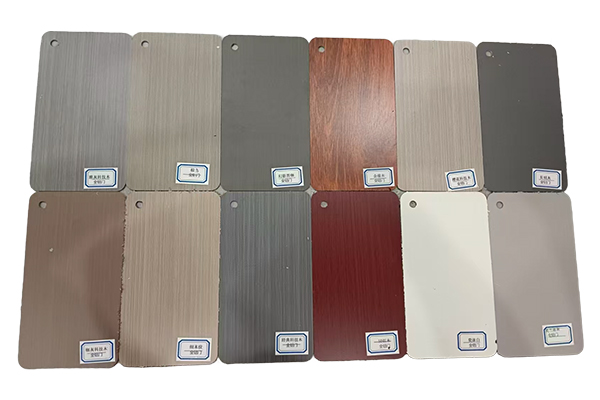How can aluminum door hardware accessories ensure long-term structural stability under high-frequency use?
Release Time : 2025-07-07
In modern buildings, aluminum doors are widely used in residential, commercial and public places because of their lightness, beauty and durability. As an important part of the aluminum door system, hardware accessories not only bear key functions such as connection, opening and closing, and load-bearing, but also bear frequent mechanical stress and environmental impact in daily high-frequency use.
1. High-strength material selection is the basic guarantee
Aluminum door hardware accessories are usually made of materials such as aluminum alloy, stainless steel, copper alloy or engineering plastics. Among them, high-quality aluminum alloy is one of the preferred materials because of its low density, high strength and strong corrosion resistance. Through specific heat treatment processes (such as T6 aging treatment), the hardness and fatigue resistance of aluminum alloy can be significantly improved, so that it can maintain good structural integrity during repeated opening, closing, pushing and pulling.
In addition, some key components such as hinges, handles, slide rails, etc. are often made of stainless steel or zinc alloy to enhance their wear resistance and load-bearing capacity. These materials have high yield strength and deformation resistance, which can effectively cope with the pressure of frequent use and extend service life.
2. Precision machining and surface treatment technology improves durability
In addition to the selection of raw materials, precision machining technology is also crucial to the structural stability of aluminum door hardware accessories. Modern hardware manufacturing generally adopts advanced processes such as CNC machine tools, stamping, forging, etc. to ensure that each part is accurate in size and tightly matched, thereby reducing shaking and wear caused by loose assembly.
At the same time, in order to further improve the durability of the product, hardware accessories will also undergo a variety of surface treatment processes, such as anodizing, electroplating, powder spraying, sandblasting, etc. These processes can not only improve the hardness and smoothness of the metal surface, but also form a protective film to prevent oxidation, corrosion and scratches, so that the product can maintain stable performance in long-term use.
3. Structural optimization design improves fatigue resistance
Aluminum door hardware accessories will continue to experience opening and closing, rotation, sliding and other actions under high-frequency use, which puts higher requirements on the fatigue resistance of the structure. To this end, manufacturers fully considered the force distribution problem in the design stage, using engineering methods such as finite element analysis (FEA) to simulate actual usage scenarios and strengthen the design of key parts.
For example, the hinge adopts a dual-axis or multi-point support structure to disperse the force; the slide rail adopts an arc-shaped guide groove design to reduce friction resistance; a buffer device is set inside the handle to reduce the impact caused by sudden force. These optimized designs effectively improve the overall structural strength of the hardware and reduce the risk of fatigue fracture due to long-term use.
4. Reasonable installation and matching accuracy to ensure overall stability
Even if the hardware accessories themselves are of good quality, if they are improperly installed, they will seriously affect their structural stability. Therefore, during the installation of the aluminum door hardware system, it is necessary to strictly follow the specifications to ensure that the matching clearance between the various components is controlled within a reasonable range.
For example, when installing the hinge, verticality and parallelism must be ensured to avoid additional stress caused by offset; the slide rail installation must be kept horizontal to prevent jamming or derailment; the alignment of the lock and the lock seat must also be accurate to avoid poor bite or damage to the lock core. Reasonable installation methods can not only improve the comfort of use, but also effectively extend the service life of hardware accessories.
5. Application of anti-loosening fasteners and self-lubricating technology
In high-frequency use environments, screw loosening is a common but easily overlooked problem. To solve this problem, many high-quality aluminum door hardware accessories use designs such as anti-loosening screws, spring washers or self-locking nuts to ensure that the connection is firm and not easy to fall off.
In addition, some moving parts also introduce self-lubricating technology, such as inlaying graphite or using POM engineering plastics, to reduce the loss caused by friction, so that the hardware accessories can still remain smooth and noise-free during long-term operation, further improving the stability of the overall structure.
In summary, the reason why aluminum door hardware accessories can maintain good structural stability under high-frequency use is due to the comprehensive optimization of multiple aspects from material selection, processing technology, structural design to installation details.
1. High-strength material selection is the basic guarantee
Aluminum door hardware accessories are usually made of materials such as aluminum alloy, stainless steel, copper alloy or engineering plastics. Among them, high-quality aluminum alloy is one of the preferred materials because of its low density, high strength and strong corrosion resistance. Through specific heat treatment processes (such as T6 aging treatment), the hardness and fatigue resistance of aluminum alloy can be significantly improved, so that it can maintain good structural integrity during repeated opening, closing, pushing and pulling.
In addition, some key components such as hinges, handles, slide rails, etc. are often made of stainless steel or zinc alloy to enhance their wear resistance and load-bearing capacity. These materials have high yield strength and deformation resistance, which can effectively cope with the pressure of frequent use and extend service life.
2. Precision machining and surface treatment technology improves durability
In addition to the selection of raw materials, precision machining technology is also crucial to the structural stability of aluminum door hardware accessories. Modern hardware manufacturing generally adopts advanced processes such as CNC machine tools, stamping, forging, etc. to ensure that each part is accurate in size and tightly matched, thereby reducing shaking and wear caused by loose assembly.
At the same time, in order to further improve the durability of the product, hardware accessories will also undergo a variety of surface treatment processes, such as anodizing, electroplating, powder spraying, sandblasting, etc. These processes can not only improve the hardness and smoothness of the metal surface, but also form a protective film to prevent oxidation, corrosion and scratches, so that the product can maintain stable performance in long-term use.
3. Structural optimization design improves fatigue resistance
Aluminum door hardware accessories will continue to experience opening and closing, rotation, sliding and other actions under high-frequency use, which puts higher requirements on the fatigue resistance of the structure. To this end, manufacturers fully considered the force distribution problem in the design stage, using engineering methods such as finite element analysis (FEA) to simulate actual usage scenarios and strengthen the design of key parts.
For example, the hinge adopts a dual-axis or multi-point support structure to disperse the force; the slide rail adopts an arc-shaped guide groove design to reduce friction resistance; a buffer device is set inside the handle to reduce the impact caused by sudden force. These optimized designs effectively improve the overall structural strength of the hardware and reduce the risk of fatigue fracture due to long-term use.
4. Reasonable installation and matching accuracy to ensure overall stability
Even if the hardware accessories themselves are of good quality, if they are improperly installed, they will seriously affect their structural stability. Therefore, during the installation of the aluminum door hardware system, it is necessary to strictly follow the specifications to ensure that the matching clearance between the various components is controlled within a reasonable range.
For example, when installing the hinge, verticality and parallelism must be ensured to avoid additional stress caused by offset; the slide rail installation must be kept horizontal to prevent jamming or derailment; the alignment of the lock and the lock seat must also be accurate to avoid poor bite or damage to the lock core. Reasonable installation methods can not only improve the comfort of use, but also effectively extend the service life of hardware accessories.
5. Application of anti-loosening fasteners and self-lubricating technology
In high-frequency use environments, screw loosening is a common but easily overlooked problem. To solve this problem, many high-quality aluminum door hardware accessories use designs such as anti-loosening screws, spring washers or self-locking nuts to ensure that the connection is firm and not easy to fall off.
In addition, some moving parts also introduce self-lubricating technology, such as inlaying graphite or using POM engineering plastics, to reduce the loss caused by friction, so that the hardware accessories can still remain smooth and noise-free during long-term operation, further improving the stability of the overall structure.
In summary, the reason why aluminum door hardware accessories can maintain good structural stability under high-frequency use is due to the comprehensive optimization of multiple aspects from material selection, processing technology, structural design to installation details.







